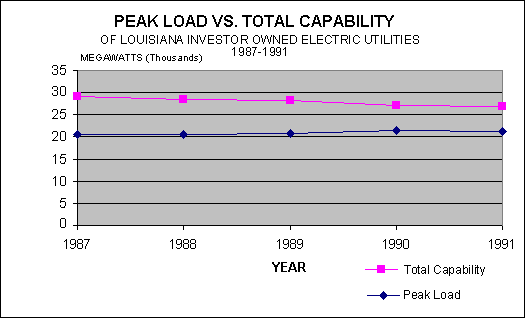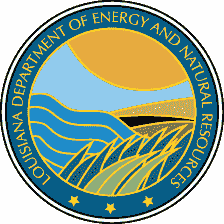Technology Assessment Division
The Energy Policy Act of 1992 and Louisiana's Electric Power Industry
February 1993
by Alan A. Troy, P.E.
The Energy Policy Act of 1992 is designed to encourage competition in energy markets. A persistent capacity surplus discourages new entrants into the Louisiana market (See chart on back). The Act makes it easier for utilities to own unregulated independent power facilities and invest in power projects in other states and countries. Two large multi-state investor-owned utility holding companies operating in Louisiana are making such investments. The smaller, independent Louisiana utilities lack the resources for such ventures and are likely to stay close to their home bases.
The Act amends the Public Utility Holding Company Act of 1935 (PUHCA) by creating a new class of power producers, called exempt wholesale generators (EWG's), that are not subject to PUHCA and are exclusively engaged in owning and/or operating facilities generating electricity for sale at wholesale. They can be independent companies, or the utilities can own them. In addition, the utilities can now make foreign investments without SEC approval, within certain restrictions.
Entergy Corporation, the multi-state New Orleans based holding company for Louisiana Power & Light and New Orleans Public Service Co., has transferred two of its Arkansas plants to its independent power subsidiary, Entergy Power, Inc., and is investing $515 million in two utilities in Argentina through it Entergy Services subsidiary. Dallas based Central & South West Corp., the holding company for Southwestern Electric Power Co., Shreveport, is participating in independent power projects in Florida and Washington State through its CSW Energy subsidiary. Spokesmen for the other utilities operating in the state indicated they are not presently seeking to own EWG's or invest in foreign countries, but might consider it in the future.
A key provision of the Act mandates open access of the transmission systems of private and public utilities to all wholesale power producers provided they pay the entire cost of transmission as determined by the Federal Energy Regulatory Commission (FERC). This could make it easier for the Louisiana Energy and Power Authority and Cajun Electric Cooperative, which have very little transmission capability, to gain access to potential new members. Also, Louisiana's fourteen cogenerators presently selling power to Louisiana utilities now have the right to have it wheeled anywhere they choose.
Although FERC is empowered to order wheeling, it is not required to do so if service to the transmitting utilities' existing customers is impaired. Since transmission lines are in the rate base established by the Louisiana Public Service Commission (LPSC), there will have to be some collaboration between the FERC and the LPSC on rates. Pricing is sure to dominate the issues open access has created.
The Act directs state regulatory commissions to look at the effects of wholesale power purchases on utility cost of capital and to consider utility investments in energy conservation and efficiency in the rate-making process so such investments are as profitable as those in new generating plants. The idea is to provide a financial incentive for utilities to use measures other than building new power plants to meet their customers' needs. Even without this incentive every Louisiana utility is planning or is implementing such measures.
While the country finally has an energy policy, many of the regulations needed to implement it are not in place. The burden of providing this regulatory framework is still the domain of the FERC and state public service commissions as it was before the Act was passed. In the months to come it will be interesting to see what they do.
 |
|
| Source: Annual Reports of Central Louisiana Electric Co., Gulf States Utilities, Southwestern Electric Power Co., Entergy Corp. SEC 10K Forms and Company Representative. |
|
| Note: In 1990 Entergy Corp reduced its total system capability by 809 megawatts when it sold two Arkansas power plants to its independent power subsidiary, Entergy Power |
|
||||||||||||||||||||||||||||||||||||||||||||||||||||||||||||||||||||||||||||||||||||||||||||||||||||||||||||||||||||||||||||||||||||||||||||||||||||||||||||||||||||||||||||||||||||||||||||||||||||||||
